Organizational Change Management: Report for The Last Resort, Tasmania
VerifiedAdded on 2021/06/17
|16
|3979
|50
Report
AI Summary
This report develops a change management strategy for The Last Resort (TLR) in Tasmania, focusing on the tourism and hospitality sector's growth and the need for internal changes. It analyzes challenges such as labor shortages, decreasing repeat customers, and external pressures, while also identifying opportunities like the increasing demand from North Asian and Indian visitors. The report applies Lewin’s and Kotter’s change management models to justify a strategy including training and education, improved communication, and local recruitment. It addresses potential barriers like resistance to change and ethical issues, proposing solutions to ensure successful implementation. The report provides a comprehensive overview of the organization's current state, challenges, opportunities, and a strategic plan for future growth.
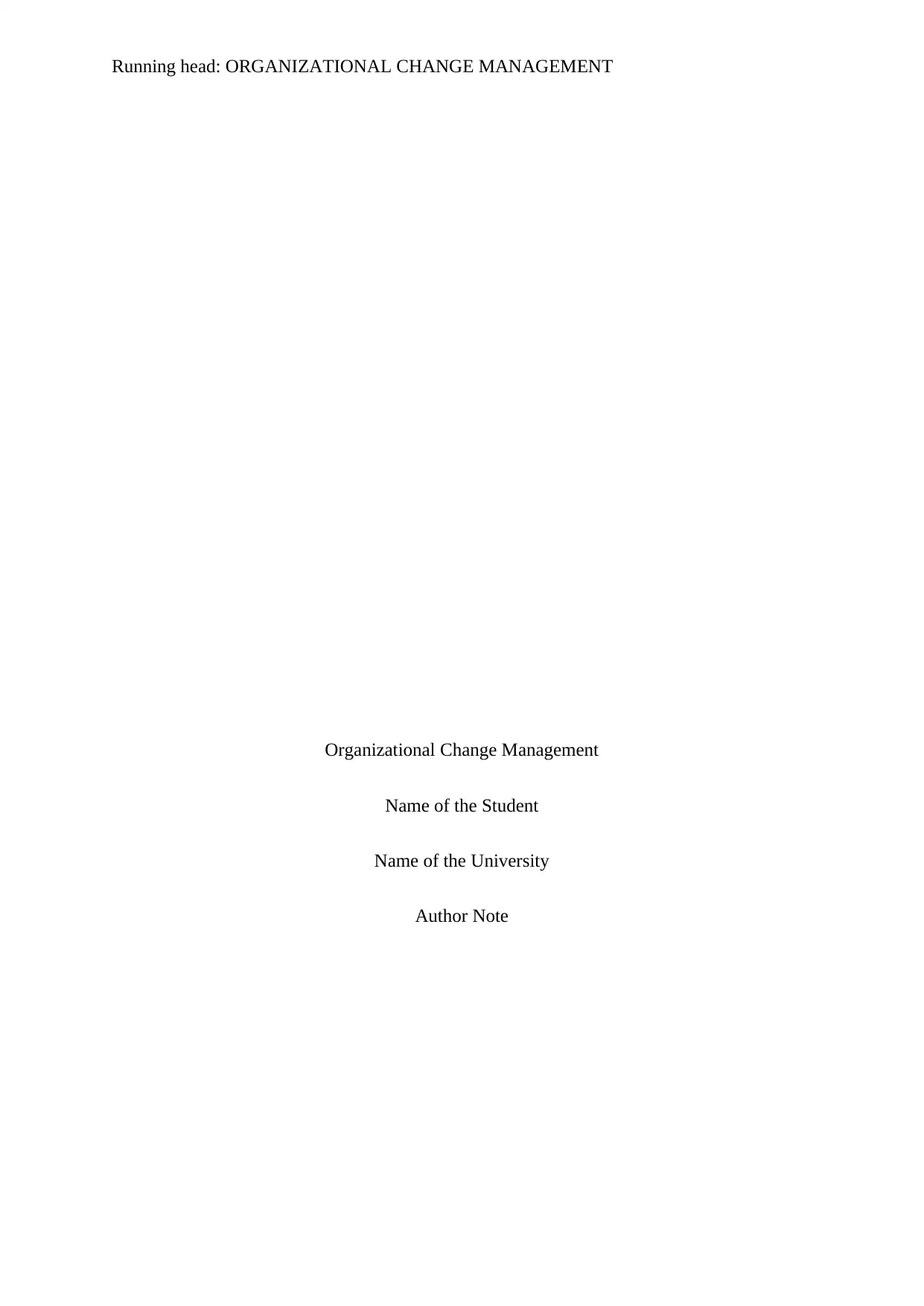
Running head: ORGANIZATIONAL CHANGE MANAGEMENT
Organizational Change Management
Name of the Student
Name of the University
Author Note
Organizational Change Management
Name of the Student
Name of the University
Author Note
Paraphrase This Document
Need a fresh take? Get an instant paraphrase of this document with our AI Paraphraser
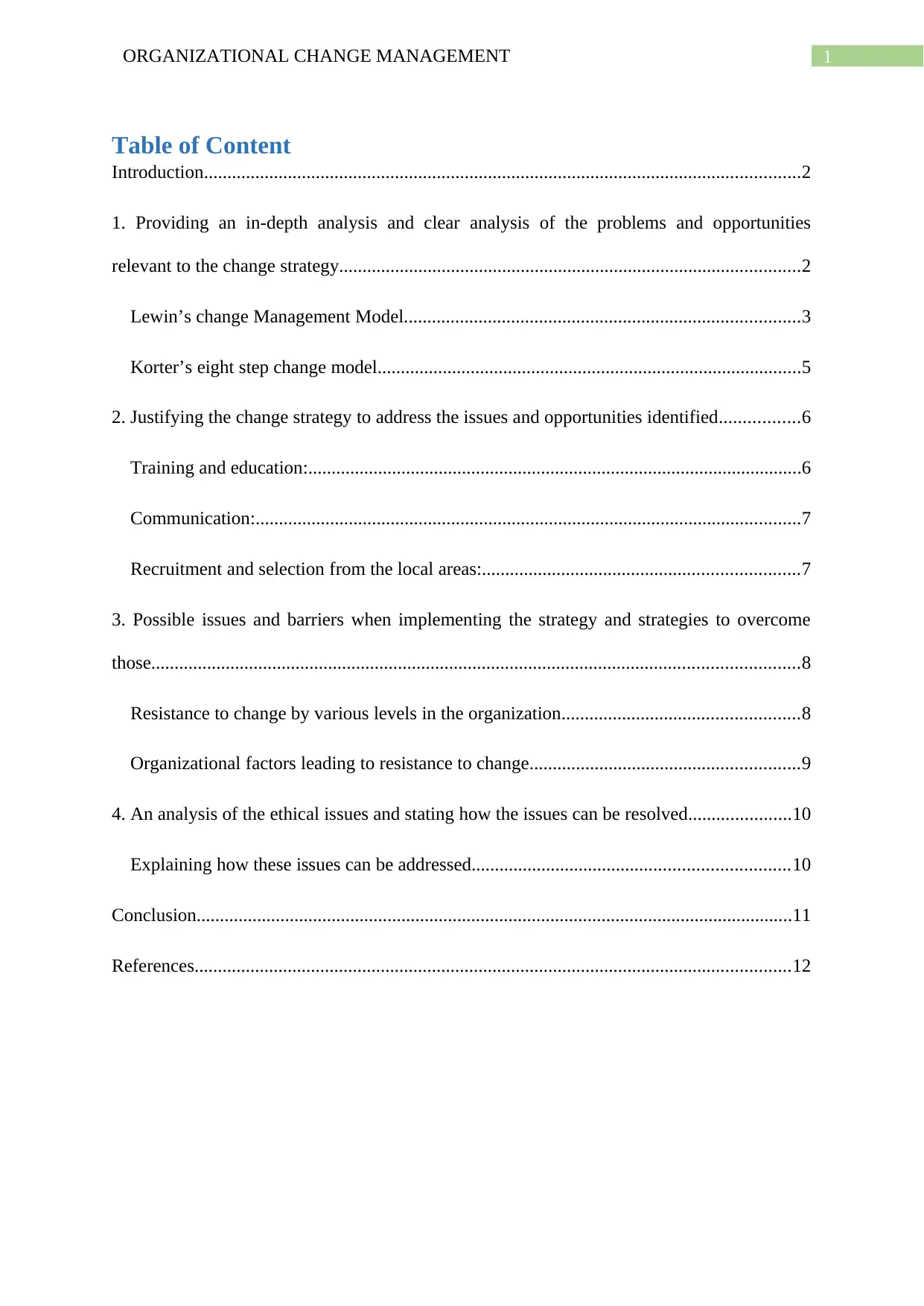
1ORGANIZATIONAL CHANGE MANAGEMENT
Table of Content
Introduction................................................................................................................................2
1. Providing an in-depth analysis and clear analysis of the problems and opportunities
relevant to the change strategy...................................................................................................2
Lewin’s change Management Model.....................................................................................3
Korter’s eight step change model...........................................................................................5
2. Justifying the change strategy to address the issues and opportunities identified.................6
Training and education:..........................................................................................................6
Communication:.....................................................................................................................7
Recruitment and selection from the local areas:....................................................................7
3. Possible issues and barriers when implementing the strategy and strategies to overcome
those...........................................................................................................................................8
Resistance to change by various levels in the organization...................................................8
Organizational factors leading to resistance to change..........................................................9
4. An analysis of the ethical issues and stating how the issues can be resolved......................10
Explaining how these issues can be addressed....................................................................10
Conclusion................................................................................................................................11
References................................................................................................................................12
Table of Content
Introduction................................................................................................................................2
1. Providing an in-depth analysis and clear analysis of the problems and opportunities
relevant to the change strategy...................................................................................................2
Lewin’s change Management Model.....................................................................................3
Korter’s eight step change model...........................................................................................5
2. Justifying the change strategy to address the issues and opportunities identified.................6
Training and education:..........................................................................................................6
Communication:.....................................................................................................................7
Recruitment and selection from the local areas:....................................................................7
3. Possible issues and barriers when implementing the strategy and strategies to overcome
those...........................................................................................................................................8
Resistance to change by various levels in the organization...................................................8
Organizational factors leading to resistance to change..........................................................9
4. An analysis of the ethical issues and stating how the issues can be resolved......................10
Explaining how these issues can be addressed....................................................................10
Conclusion................................................................................................................................11
References................................................................................................................................12
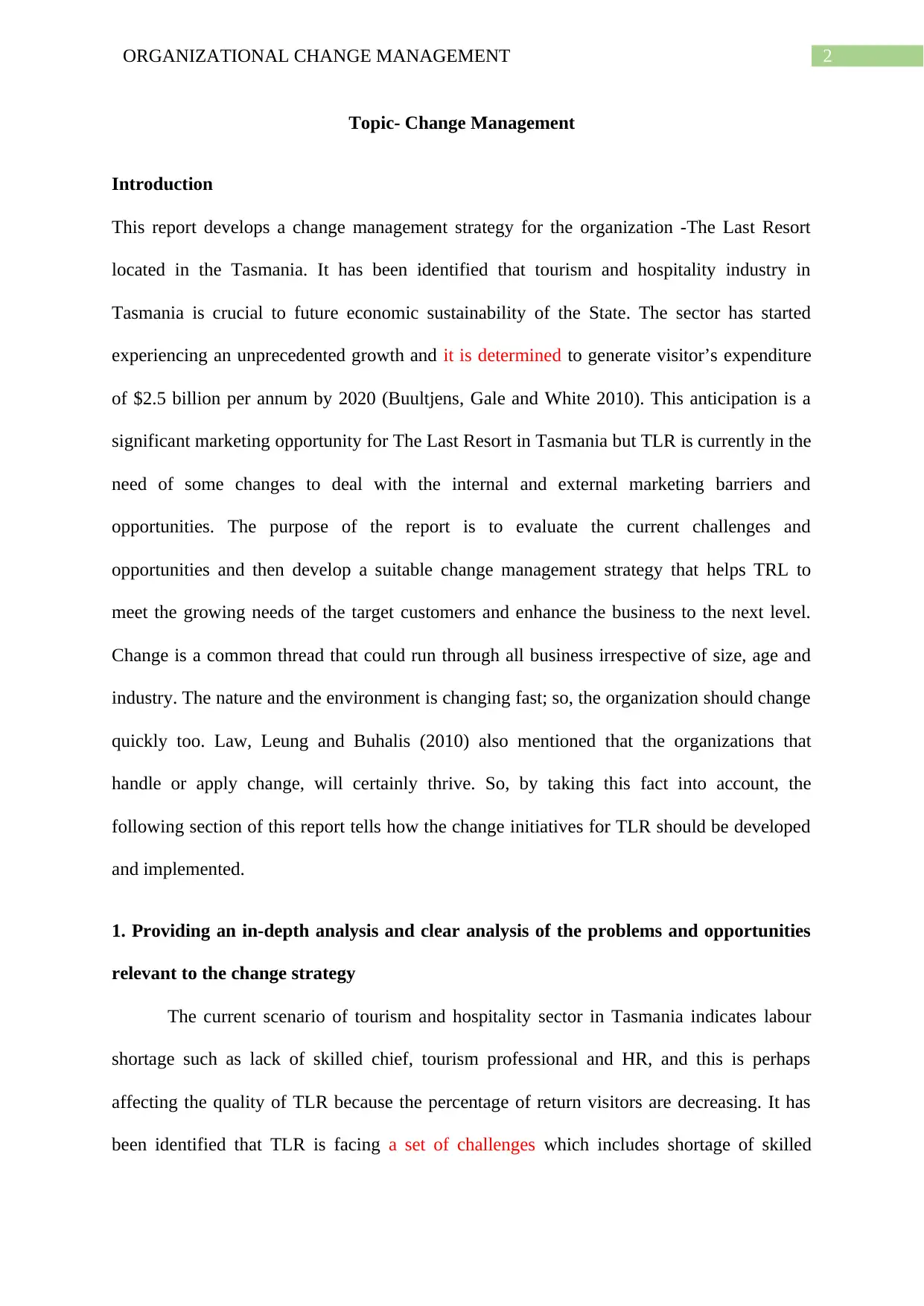
2ORGANIZATIONAL CHANGE MANAGEMENT
Topic- Change Management
Introduction
This report develops a change management strategy for the organization -The Last Resort
located in the Tasmania. It has been identified that tourism and hospitality industry in
Tasmania is crucial to future economic sustainability of the State. The sector has started
experiencing an unprecedented growth and it is determined to generate visitor’s expenditure
of $2.5 billion per annum by 2020 (Buultjens, Gale and White 2010). This anticipation is a
significant marketing opportunity for The Last Resort in Tasmania but TLR is currently in the
need of some changes to deal with the internal and external marketing barriers and
opportunities. The purpose of the report is to evaluate the current challenges and
opportunities and then develop a suitable change management strategy that helps TRL to
meet the growing needs of the target customers and enhance the business to the next level.
Change is a common thread that could run through all business irrespective of size, age and
industry. The nature and the environment is changing fast; so, the organization should change
quickly too. Law, Leung and Buhalis (2010) also mentioned that the organizations that
handle or apply change, will certainly thrive. So, by taking this fact into account, the
following section of this report tells how the change initiatives for TLR should be developed
and implemented.
1. Providing an in-depth analysis and clear analysis of the problems and opportunities
relevant to the change strategy
The current scenario of tourism and hospitality sector in Tasmania indicates labour
shortage such as lack of skilled chief, tourism professional and HR, and this is perhaps
affecting the quality of TLR because the percentage of return visitors are decreasing. It has
been identified that TLR is facing a set of challenges which includes shortage of skilled
Topic- Change Management
Introduction
This report develops a change management strategy for the organization -The Last Resort
located in the Tasmania. It has been identified that tourism and hospitality industry in
Tasmania is crucial to future economic sustainability of the State. The sector has started
experiencing an unprecedented growth and it is determined to generate visitor’s expenditure
of $2.5 billion per annum by 2020 (Buultjens, Gale and White 2010). This anticipation is a
significant marketing opportunity for The Last Resort in Tasmania but TLR is currently in the
need of some changes to deal with the internal and external marketing barriers and
opportunities. The purpose of the report is to evaluate the current challenges and
opportunities and then develop a suitable change management strategy that helps TRL to
meet the growing needs of the target customers and enhance the business to the next level.
Change is a common thread that could run through all business irrespective of size, age and
industry. The nature and the environment is changing fast; so, the organization should change
quickly too. Law, Leung and Buhalis (2010) also mentioned that the organizations that
handle or apply change, will certainly thrive. So, by taking this fact into account, the
following section of this report tells how the change initiatives for TLR should be developed
and implemented.
1. Providing an in-depth analysis and clear analysis of the problems and opportunities
relevant to the change strategy
The current scenario of tourism and hospitality sector in Tasmania indicates labour
shortage such as lack of skilled chief, tourism professional and HR, and this is perhaps
affecting the quality of TLR because the percentage of return visitors are decreasing. It has
been identified that TLR is facing a set of challenges which includes shortage of skilled
⊘ This is a preview!⊘
Do you want full access?
Subscribe today to unlock all pages.

Trusted by 1+ million students worldwide
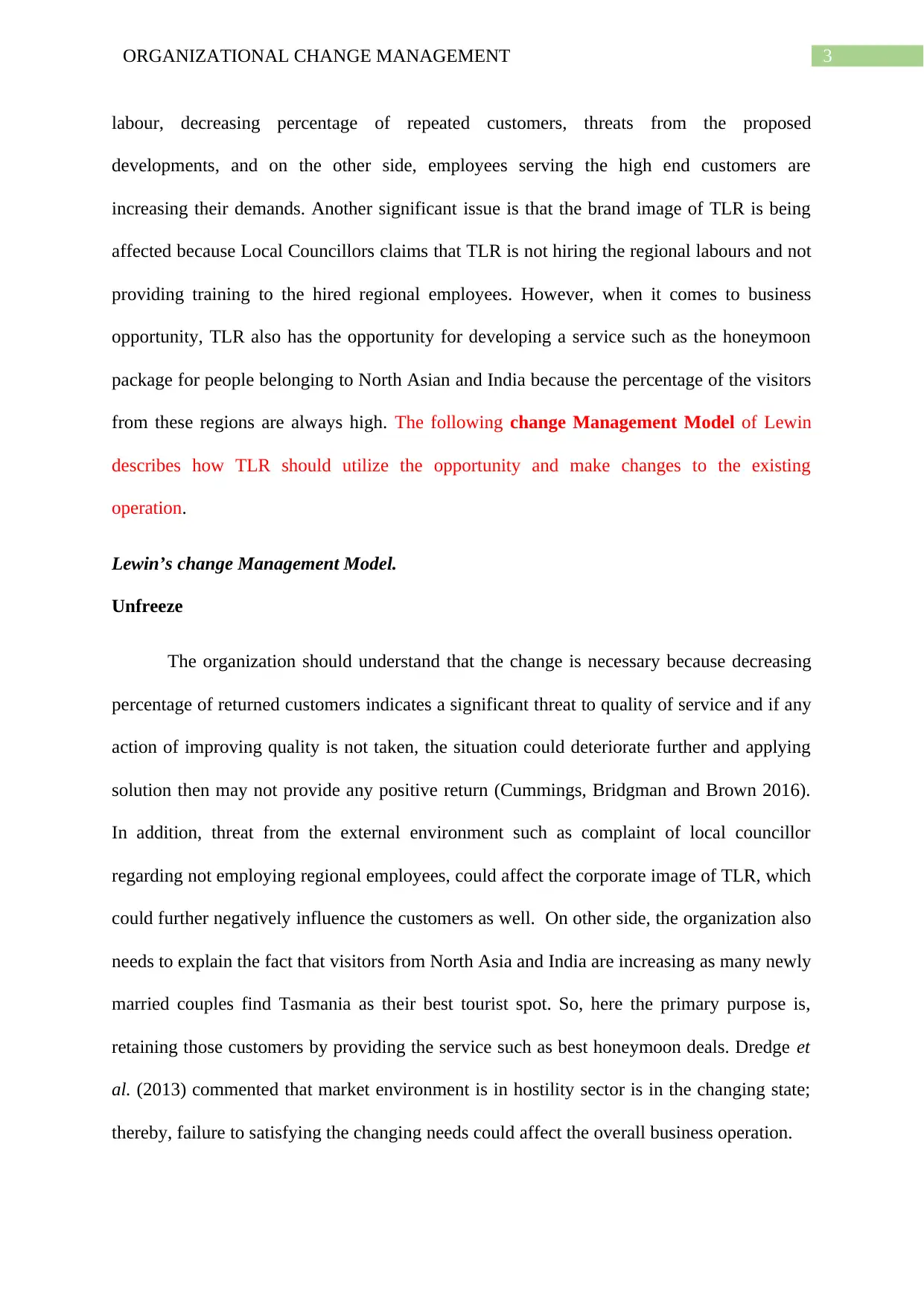
3ORGANIZATIONAL CHANGE MANAGEMENT
labour, decreasing percentage of repeated customers, threats from the proposed
developments, and on the other side, employees serving the high end customers are
increasing their demands. Another significant issue is that the brand image of TLR is being
affected because Local Councillors claims that TLR is not hiring the regional labours and not
providing training to the hired regional employees. However, when it comes to business
opportunity, TLR also has the opportunity for developing a service such as the honeymoon
package for people belonging to North Asian and India because the percentage of the visitors
from these regions are always high. The following change Management Model of Lewin
describes how TLR should utilize the opportunity and make changes to the existing
operation.
Lewin’s change Management Model.
Unfreeze
The organization should understand that the change is necessary because decreasing
percentage of returned customers indicates a significant threat to quality of service and if any
action of improving quality is not taken, the situation could deteriorate further and applying
solution then may not provide any positive return (Cummings, Bridgman and Brown 2016).
In addition, threat from the external environment such as complaint of local councillor
regarding not employing regional employees, could affect the corporate image of TLR, which
could further negatively influence the customers as well. On other side, the organization also
needs to explain the fact that visitors from North Asia and India are increasing as many newly
married couples find Tasmania as their best tourist spot. So, here the primary purpose is,
retaining those customers by providing the service such as best honeymoon deals. Dredge et
al. (2013) commented that market environment is in hostility sector is in the changing state;
thereby, failure to satisfying the changing needs could affect the overall business operation.
labour, decreasing percentage of repeated customers, threats from the proposed
developments, and on the other side, employees serving the high end customers are
increasing their demands. Another significant issue is that the brand image of TLR is being
affected because Local Councillors claims that TLR is not hiring the regional labours and not
providing training to the hired regional employees. However, when it comes to business
opportunity, TLR also has the opportunity for developing a service such as the honeymoon
package for people belonging to North Asian and India because the percentage of the visitors
from these regions are always high. The following change Management Model of Lewin
describes how TLR should utilize the opportunity and make changes to the existing
operation.
Lewin’s change Management Model.
Unfreeze
The organization should understand that the change is necessary because decreasing
percentage of returned customers indicates a significant threat to quality of service and if any
action of improving quality is not taken, the situation could deteriorate further and applying
solution then may not provide any positive return (Cummings, Bridgman and Brown 2016).
In addition, threat from the external environment such as complaint of local councillor
regarding not employing regional employees, could affect the corporate image of TLR, which
could further negatively influence the customers as well. On other side, the organization also
needs to explain the fact that visitors from North Asia and India are increasing as many newly
married couples find Tasmania as their best tourist spot. So, here the primary purpose is,
retaining those customers by providing the service such as best honeymoon deals. Dredge et
al. (2013) commented that market environment is in hostility sector is in the changing state;
thereby, failure to satisfying the changing needs could affect the overall business operation.
Paraphrase This Document
Need a fresh take? Get an instant paraphrase of this document with our AI Paraphraser
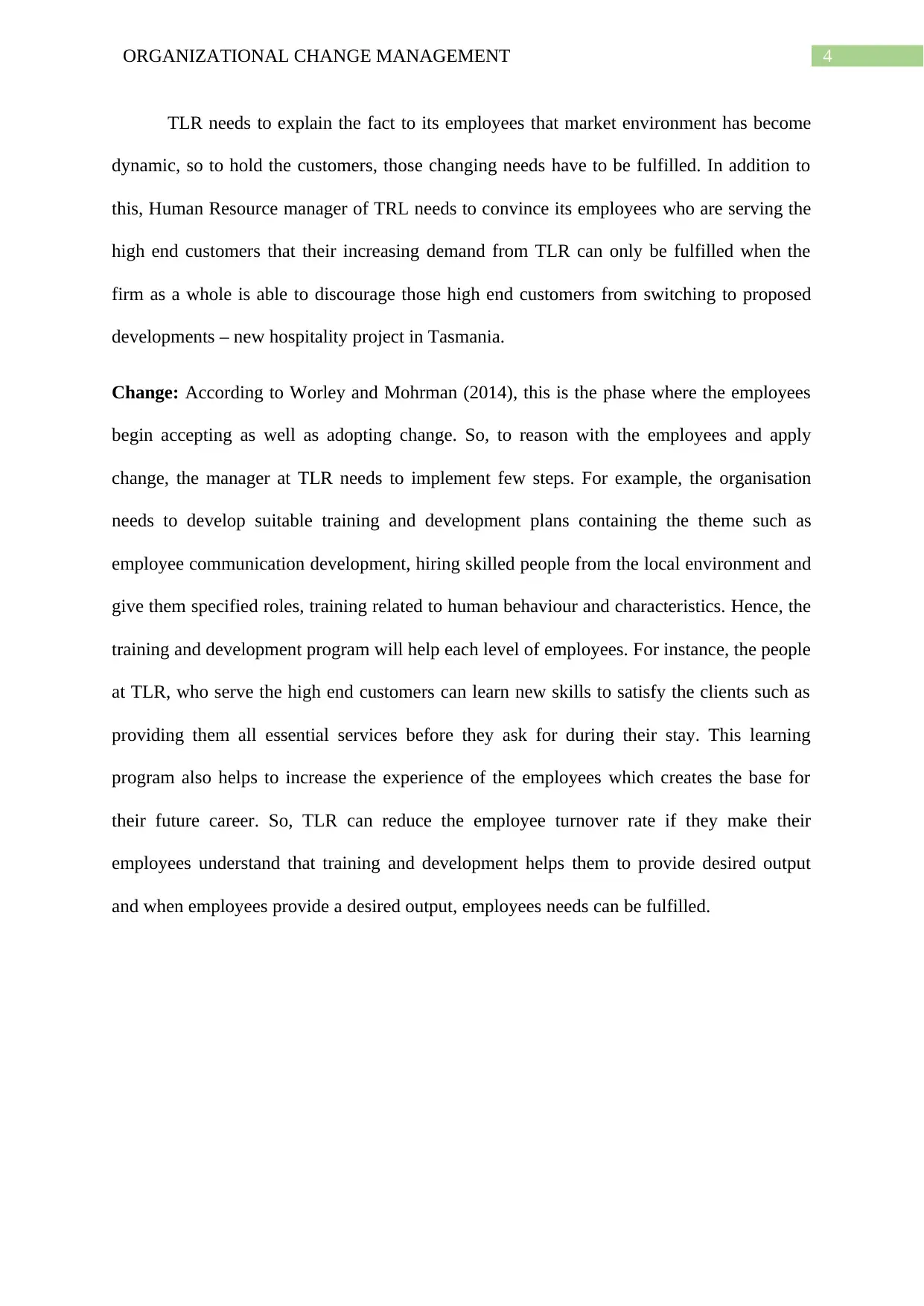
4ORGANIZATIONAL CHANGE MANAGEMENT
TLR needs to explain the fact to its employees that market environment has become
dynamic, so to hold the customers, those changing needs have to be fulfilled. In addition to
this, Human Resource manager of TRL needs to convince its employees who are serving the
high end customers that their increasing demand from TLR can only be fulfilled when the
firm as a whole is able to discourage those high end customers from switching to proposed
developments – new hospitality project in Tasmania.
Change: According to Worley and Mohrman (2014), this is the phase where the employees
begin accepting as well as adopting change. So, to reason with the employees and apply
change, the manager at TLR needs to implement few steps. For example, the organisation
needs to develop suitable training and development plans containing the theme such as
employee communication development, hiring skilled people from the local environment and
give them specified roles, training related to human behaviour and characteristics. Hence, the
training and development program will help each level of employees. For instance, the people
at TLR, who serve the high end customers can learn new skills to satisfy the clients such as
providing them all essential services before they ask for during their stay. This learning
program also helps to increase the experience of the employees which creates the base for
their future career. So, TLR can reduce the employee turnover rate if they make their
employees understand that training and development helps them to provide desired output
and when employees provide a desired output, employees needs can be fulfilled.
TLR needs to explain the fact to its employees that market environment has become
dynamic, so to hold the customers, those changing needs have to be fulfilled. In addition to
this, Human Resource manager of TRL needs to convince its employees who are serving the
high end customers that their increasing demand from TLR can only be fulfilled when the
firm as a whole is able to discourage those high end customers from switching to proposed
developments – new hospitality project in Tasmania.
Change: According to Worley and Mohrman (2014), this is the phase where the employees
begin accepting as well as adopting change. So, to reason with the employees and apply
change, the manager at TLR needs to implement few steps. For example, the organisation
needs to develop suitable training and development plans containing the theme such as
employee communication development, hiring skilled people from the local environment and
give them specified roles, training related to human behaviour and characteristics. Hence, the
training and development program will help each level of employees. For instance, the people
at TLR, who serve the high end customers can learn new skills to satisfy the clients such as
providing them all essential services before they ask for during their stay. This learning
program also helps to increase the experience of the employees which creates the base for
their future career. So, TLR can reduce the employee turnover rate if they make their
employees understand that training and development helps them to provide desired output
and when employees provide a desired output, employees needs can be fulfilled.
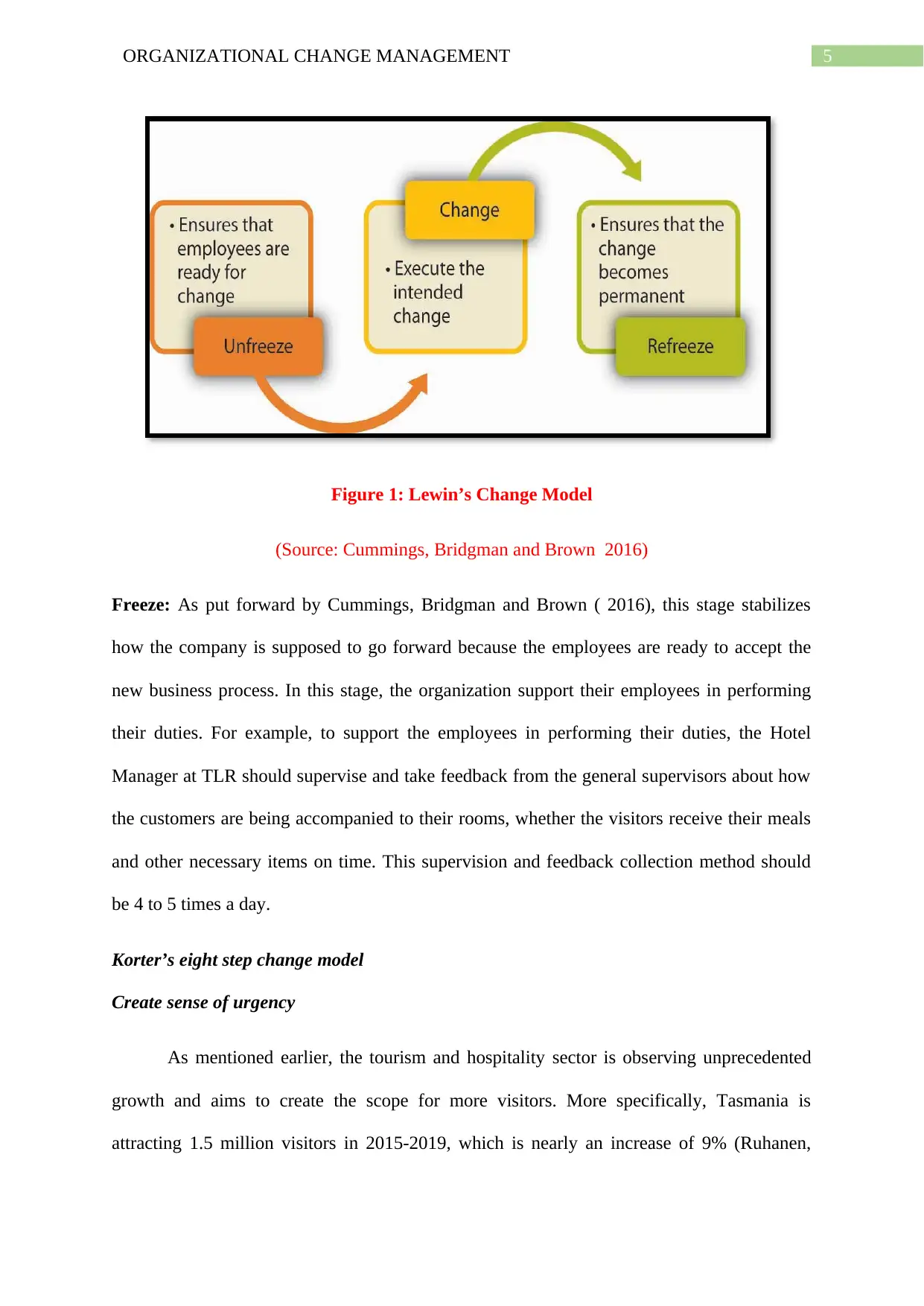
5ORGANIZATIONAL CHANGE MANAGEMENT
Figure 1: Lewin’s Change Model
(Source: Cummings, Bridgman and Brown 2016)
Freeze: As put forward by Cummings, Bridgman and Brown ( 2016), this stage stabilizes
how the company is supposed to go forward because the employees are ready to accept the
new business process. In this stage, the organization support their employees in performing
their duties. For example, to support the employees in performing their duties, the Hotel
Manager at TLR should supervise and take feedback from the general supervisors about how
the customers are being accompanied to their rooms, whether the visitors receive their meals
and other necessary items on time. This supervision and feedback collection method should
be 4 to 5 times a day.
Korter’s eight step change model
Create sense of urgency
As mentioned earlier, the tourism and hospitality sector is observing unprecedented
growth and aims to create the scope for more visitors. More specifically, Tasmania is
attracting 1.5 million visitors in 2015-2019, which is nearly an increase of 9% (Ruhanen,
Figure 1: Lewin’s Change Model
(Source: Cummings, Bridgman and Brown 2016)
Freeze: As put forward by Cummings, Bridgman and Brown ( 2016), this stage stabilizes
how the company is supposed to go forward because the employees are ready to accept the
new business process. In this stage, the organization support their employees in performing
their duties. For example, to support the employees in performing their duties, the Hotel
Manager at TLR should supervise and take feedback from the general supervisors about how
the customers are being accompanied to their rooms, whether the visitors receive their meals
and other necessary items on time. This supervision and feedback collection method should
be 4 to 5 times a day.
Korter’s eight step change model
Create sense of urgency
As mentioned earlier, the tourism and hospitality sector is observing unprecedented
growth and aims to create the scope for more visitors. More specifically, Tasmania is
attracting 1.5 million visitors in 2015-2019, which is nearly an increase of 9% (Ruhanen,
⊘ This is a preview!⊘
Do you want full access?
Subscribe today to unlock all pages.

Trusted by 1+ million students worldwide
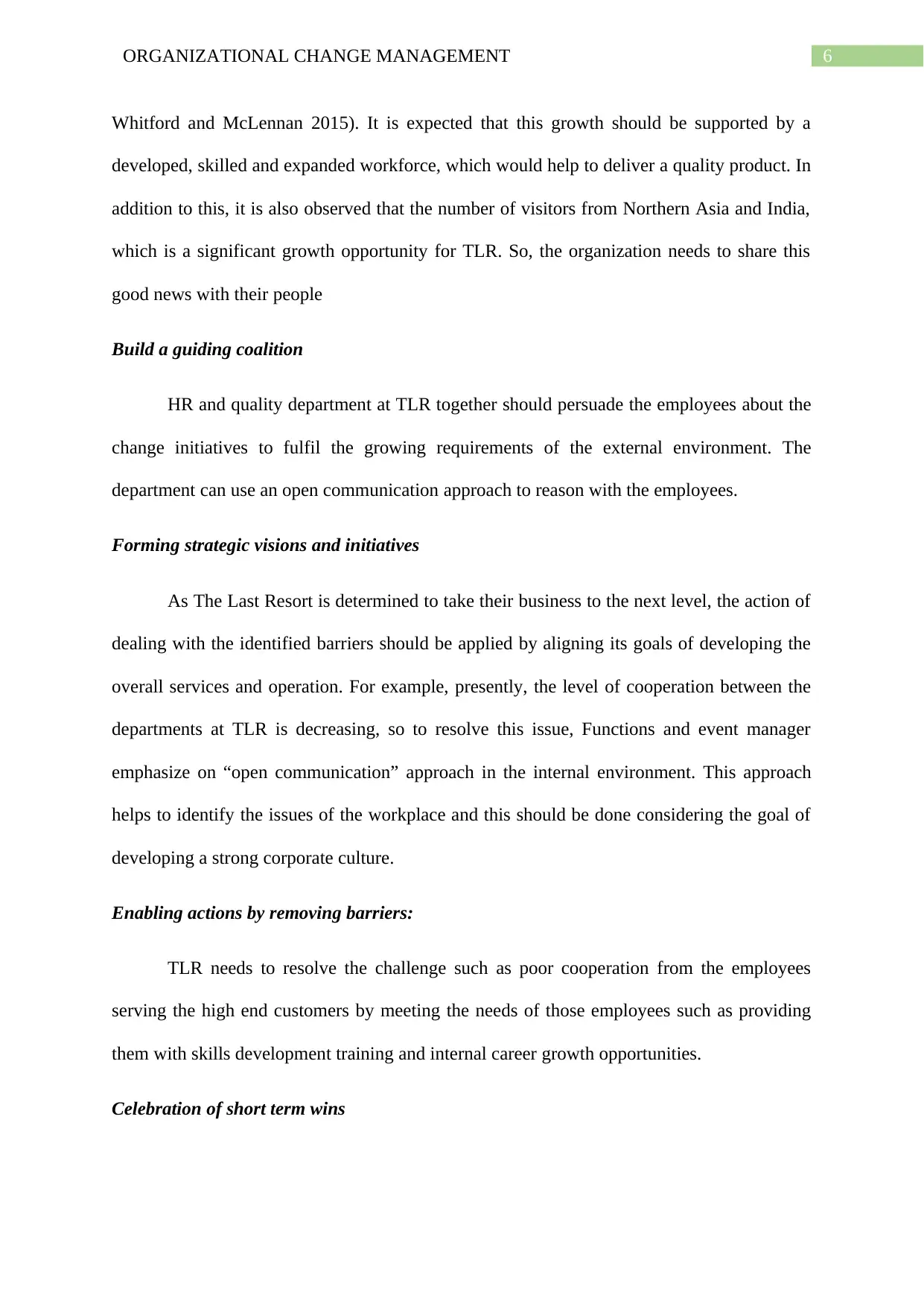
6ORGANIZATIONAL CHANGE MANAGEMENT
Whitford and McLennan 2015). It is expected that this growth should be supported by a
developed, skilled and expanded workforce, which would help to deliver a quality product. In
addition to this, it is also observed that the number of visitors from Northern Asia and India,
which is a significant growth opportunity for TLR. So, the organization needs to share this
good news with their people
Build a guiding coalition
HR and quality department at TLR together should persuade the employees about the
change initiatives to fulfil the growing requirements of the external environment. The
department can use an open communication approach to reason with the employees.
Forming strategic visions and initiatives
As The Last Resort is determined to take their business to the next level, the action of
dealing with the identified barriers should be applied by aligning its goals of developing the
overall services and operation. For example, presently, the level of cooperation between the
departments at TLR is decreasing, so to resolve this issue, Functions and event manager
emphasize on “open communication” approach in the internal environment. This approach
helps to identify the issues of the workplace and this should be done considering the goal of
developing a strong corporate culture.
Enabling actions by removing barriers:
TLR needs to resolve the challenge such as poor cooperation from the employees
serving the high end customers by meeting the needs of those employees such as providing
them with skills development training and internal career growth opportunities.
Celebration of short term wins
Whitford and McLennan 2015). It is expected that this growth should be supported by a
developed, skilled and expanded workforce, which would help to deliver a quality product. In
addition to this, it is also observed that the number of visitors from Northern Asia and India,
which is a significant growth opportunity for TLR. So, the organization needs to share this
good news with their people
Build a guiding coalition
HR and quality department at TLR together should persuade the employees about the
change initiatives to fulfil the growing requirements of the external environment. The
department can use an open communication approach to reason with the employees.
Forming strategic visions and initiatives
As The Last Resort is determined to take their business to the next level, the action of
dealing with the identified barriers should be applied by aligning its goals of developing the
overall services and operation. For example, presently, the level of cooperation between the
departments at TLR is decreasing, so to resolve this issue, Functions and event manager
emphasize on “open communication” approach in the internal environment. This approach
helps to identify the issues of the workplace and this should be done considering the goal of
developing a strong corporate culture.
Enabling actions by removing barriers:
TLR needs to resolve the challenge such as poor cooperation from the employees
serving the high end customers by meeting the needs of those employees such as providing
them with skills development training and internal career growth opportunities.
Celebration of short term wins
Paraphrase This Document
Need a fresh take? Get an instant paraphrase of this document with our AI Paraphraser
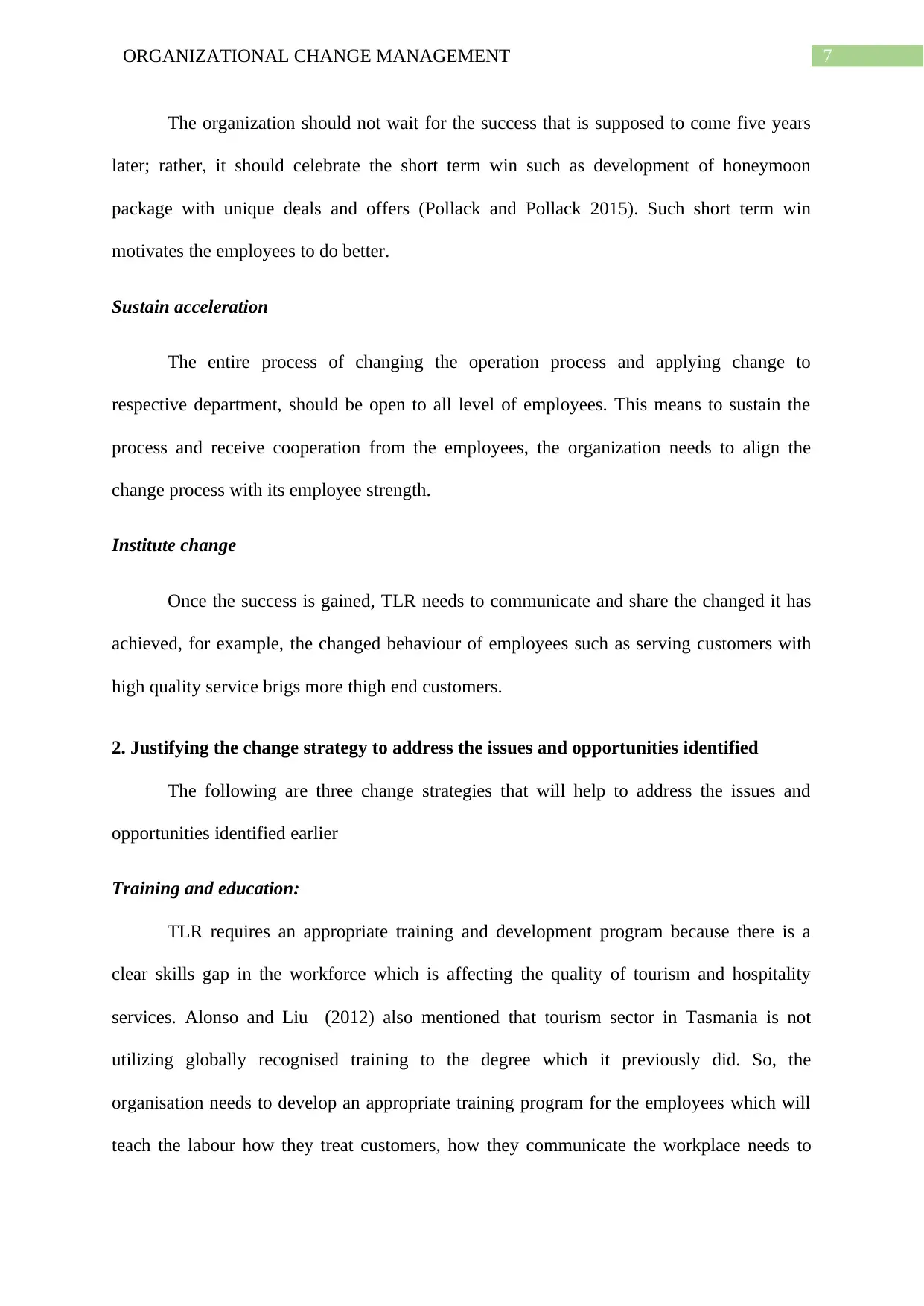
7ORGANIZATIONAL CHANGE MANAGEMENT
The organization should not wait for the success that is supposed to come five years
later; rather, it should celebrate the short term win such as development of honeymoon
package with unique deals and offers (Pollack and Pollack 2015). Such short term win
motivates the employees to do better.
Sustain acceleration
The entire process of changing the operation process and applying change to
respective department, should be open to all level of employees. This means to sustain the
process and receive cooperation from the employees, the organization needs to align the
change process with its employee strength.
Institute change
Once the success is gained, TLR needs to communicate and share the changed it has
achieved, for example, the changed behaviour of employees such as serving customers with
high quality service brigs more thigh end customers.
2. Justifying the change strategy to address the issues and opportunities identified
The following are three change strategies that will help to address the issues and
opportunities identified earlier
Training and education:
TLR requires an appropriate training and development program because there is a
clear skills gap in the workforce which is affecting the quality of tourism and hospitality
services. Alonso and Liu (2012) also mentioned that tourism sector in Tasmania is not
utilizing globally recognised training to the degree which it previously did. So, the
organisation needs to develop an appropriate training program for the employees which will
teach the labour how they treat customers, how they communicate the workplace needs to
The organization should not wait for the success that is supposed to come five years
later; rather, it should celebrate the short term win such as development of honeymoon
package with unique deals and offers (Pollack and Pollack 2015). Such short term win
motivates the employees to do better.
Sustain acceleration
The entire process of changing the operation process and applying change to
respective department, should be open to all level of employees. This means to sustain the
process and receive cooperation from the employees, the organization needs to align the
change process with its employee strength.
Institute change
Once the success is gained, TLR needs to communicate and share the changed it has
achieved, for example, the changed behaviour of employees such as serving customers with
high quality service brigs more thigh end customers.
2. Justifying the change strategy to address the issues and opportunities identified
The following are three change strategies that will help to address the issues and
opportunities identified earlier
Training and education:
TLR requires an appropriate training and development program because there is a
clear skills gap in the workforce which is affecting the quality of tourism and hospitality
services. Alonso and Liu (2012) also mentioned that tourism sector in Tasmania is not
utilizing globally recognised training to the degree which it previously did. So, the
organisation needs to develop an appropriate training program for the employees which will
teach the labour how they treat customers, how they communicate the workplace needs to
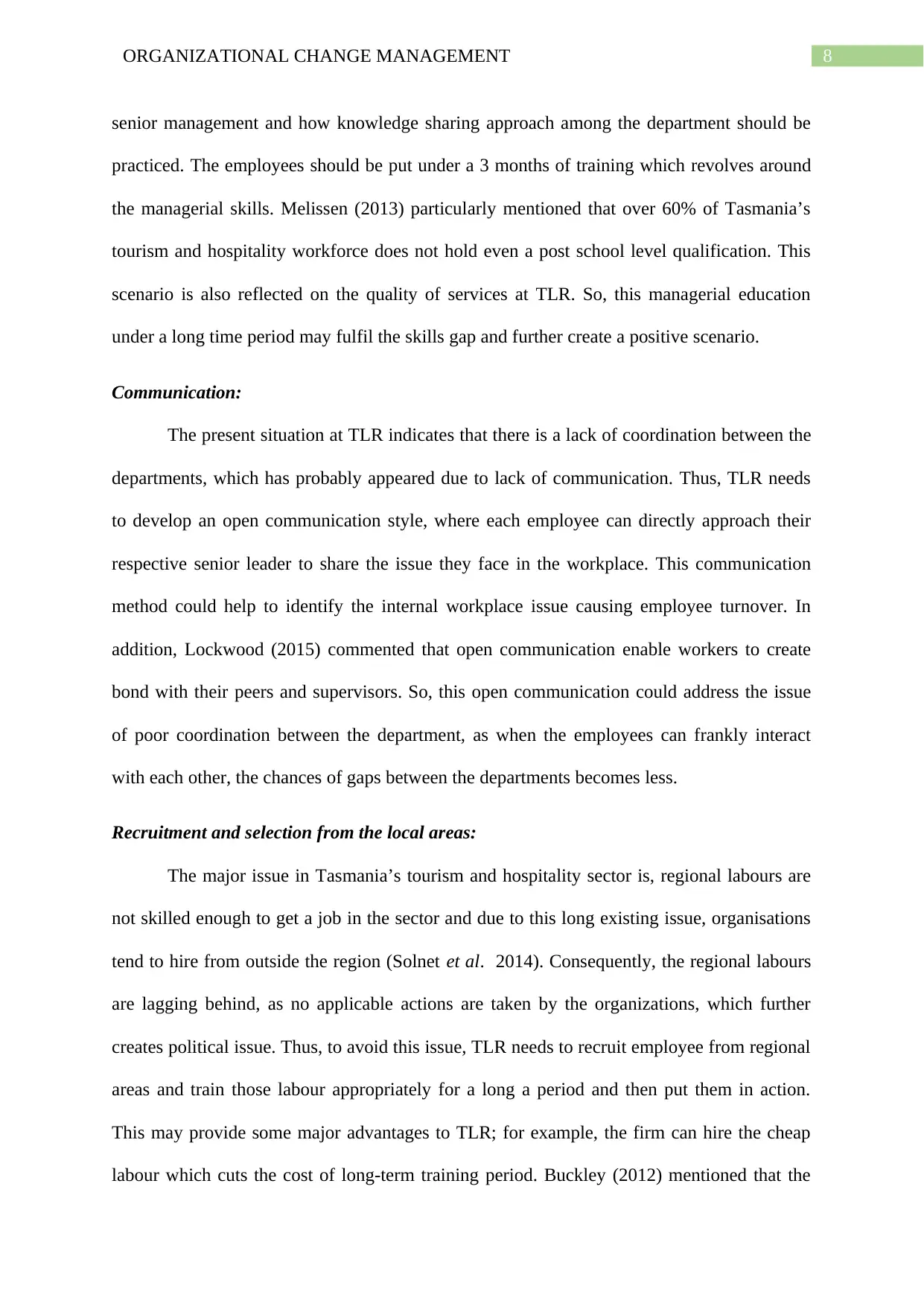
8ORGANIZATIONAL CHANGE MANAGEMENT
senior management and how knowledge sharing approach among the department should be
practiced. The employees should be put under a 3 months of training which revolves around
the managerial skills. Melissen (2013) particularly mentioned that over 60% of Tasmania’s
tourism and hospitality workforce does not hold even a post school level qualification. This
scenario is also reflected on the quality of services at TLR. So, this managerial education
under a long time period may fulfil the skills gap and further create a positive scenario.
Communication:
The present situation at TLR indicates that there is a lack of coordination between the
departments, which has probably appeared due to lack of communication. Thus, TLR needs
to develop an open communication style, where each employee can directly approach their
respective senior leader to share the issue they face in the workplace. This communication
method could help to identify the internal workplace issue causing employee turnover. In
addition, Lockwood (2015) commented that open communication enable workers to create
bond with their peers and supervisors. So, this open communication could address the issue
of poor coordination between the department, as when the employees can frankly interact
with each other, the chances of gaps between the departments becomes less.
Recruitment and selection from the local areas:
The major issue in Tasmania’s tourism and hospitality sector is, regional labours are
not skilled enough to get a job in the sector and due to this long existing issue, organisations
tend to hire from outside the region (Solnet et al. 2014). Consequently, the regional labours
are lagging behind, as no applicable actions are taken by the organizations, which further
creates political issue. Thus, to avoid this issue, TLR needs to recruit employee from regional
areas and train those labour appropriately for a long a period and then put them in action.
This may provide some major advantages to TLR; for example, the firm can hire the cheap
labour which cuts the cost of long-term training period. Buckley (2012) mentioned that the
senior management and how knowledge sharing approach among the department should be
practiced. The employees should be put under a 3 months of training which revolves around
the managerial skills. Melissen (2013) particularly mentioned that over 60% of Tasmania’s
tourism and hospitality workforce does not hold even a post school level qualification. This
scenario is also reflected on the quality of services at TLR. So, this managerial education
under a long time period may fulfil the skills gap and further create a positive scenario.
Communication:
The present situation at TLR indicates that there is a lack of coordination between the
departments, which has probably appeared due to lack of communication. Thus, TLR needs
to develop an open communication style, where each employee can directly approach their
respective senior leader to share the issue they face in the workplace. This communication
method could help to identify the internal workplace issue causing employee turnover. In
addition, Lockwood (2015) commented that open communication enable workers to create
bond with their peers and supervisors. So, this open communication could address the issue
of poor coordination between the department, as when the employees can frankly interact
with each other, the chances of gaps between the departments becomes less.
Recruitment and selection from the local areas:
The major issue in Tasmania’s tourism and hospitality sector is, regional labours are
not skilled enough to get a job in the sector and due to this long existing issue, organisations
tend to hire from outside the region (Solnet et al. 2014). Consequently, the regional labours
are lagging behind, as no applicable actions are taken by the organizations, which further
creates political issue. Thus, to avoid this issue, TLR needs to recruit employee from regional
areas and train those labour appropriately for a long a period and then put them in action.
This may provide some major advantages to TLR; for example, the firm can hire the cheap
labour which cuts the cost of long-term training period. Buckley (2012) mentioned that the
⊘ This is a preview!⊘
Do you want full access?
Subscribe today to unlock all pages.

Trusted by 1+ million students worldwide
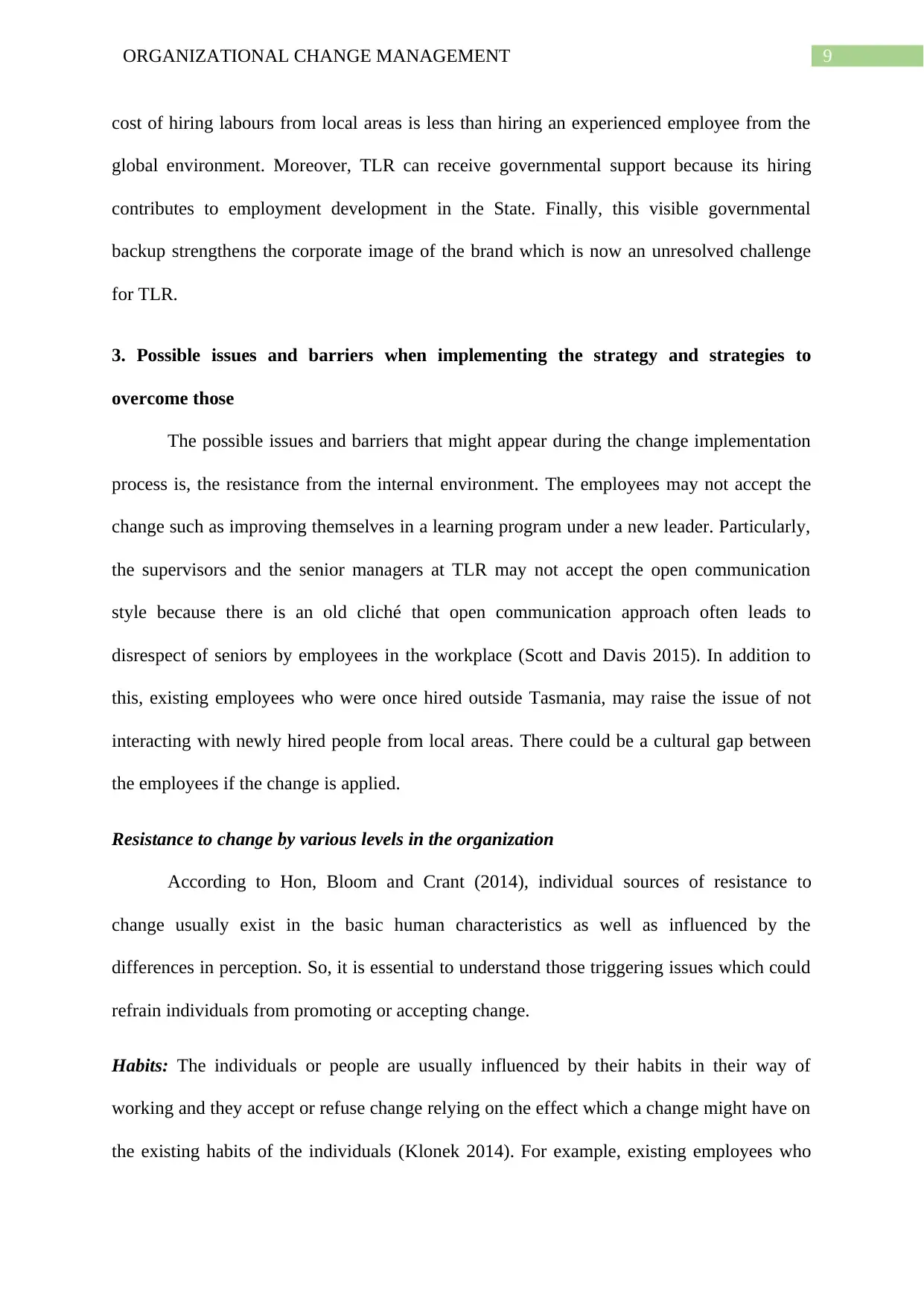
9ORGANIZATIONAL CHANGE MANAGEMENT
cost of hiring labours from local areas is less than hiring an experienced employee from the
global environment. Moreover, TLR can receive governmental support because its hiring
contributes to employment development in the State. Finally, this visible governmental
backup strengthens the corporate image of the brand which is now an unresolved challenge
for TLR.
3. Possible issues and barriers when implementing the strategy and strategies to
overcome those
The possible issues and barriers that might appear during the change implementation
process is, the resistance from the internal environment. The employees may not accept the
change such as improving themselves in a learning program under a new leader. Particularly,
the supervisors and the senior managers at TLR may not accept the open communication
style because there is an old cliché that open communication approach often leads to
disrespect of seniors by employees in the workplace (Scott and Davis 2015). In addition to
this, existing employees who were once hired outside Tasmania, may raise the issue of not
interacting with newly hired people from local areas. There could be a cultural gap between
the employees if the change is applied.
Resistance to change by various levels in the organization
According to Hon, Bloom and Crant (2014), individual sources of resistance to
change usually exist in the basic human characteristics as well as influenced by the
differences in perception. So, it is essential to understand those triggering issues which could
refrain individuals from promoting or accepting change.
Habits: The individuals or people are usually influenced by their habits in their way of
working and they accept or refuse change relying on the effect which a change might have on
the existing habits of the individuals (Klonek 2014). For example, existing employees who
cost of hiring labours from local areas is less than hiring an experienced employee from the
global environment. Moreover, TLR can receive governmental support because its hiring
contributes to employment development in the State. Finally, this visible governmental
backup strengthens the corporate image of the brand which is now an unresolved challenge
for TLR.
3. Possible issues and barriers when implementing the strategy and strategies to
overcome those
The possible issues and barriers that might appear during the change implementation
process is, the resistance from the internal environment. The employees may not accept the
change such as improving themselves in a learning program under a new leader. Particularly,
the supervisors and the senior managers at TLR may not accept the open communication
style because there is an old cliché that open communication approach often leads to
disrespect of seniors by employees in the workplace (Scott and Davis 2015). In addition to
this, existing employees who were once hired outside Tasmania, may raise the issue of not
interacting with newly hired people from local areas. There could be a cultural gap between
the employees if the change is applied.
Resistance to change by various levels in the organization
According to Hon, Bloom and Crant (2014), individual sources of resistance to
change usually exist in the basic human characteristics as well as influenced by the
differences in perception. So, it is essential to understand those triggering issues which could
refrain individuals from promoting or accepting change.
Habits: The individuals or people are usually influenced by their habits in their way of
working and they accept or refuse change relying on the effect which a change might have on
the existing habits of the individuals (Klonek 2014). For example, existing employees who
Paraphrase This Document
Need a fresh take? Get an instant paraphrase of this document with our AI Paraphraser
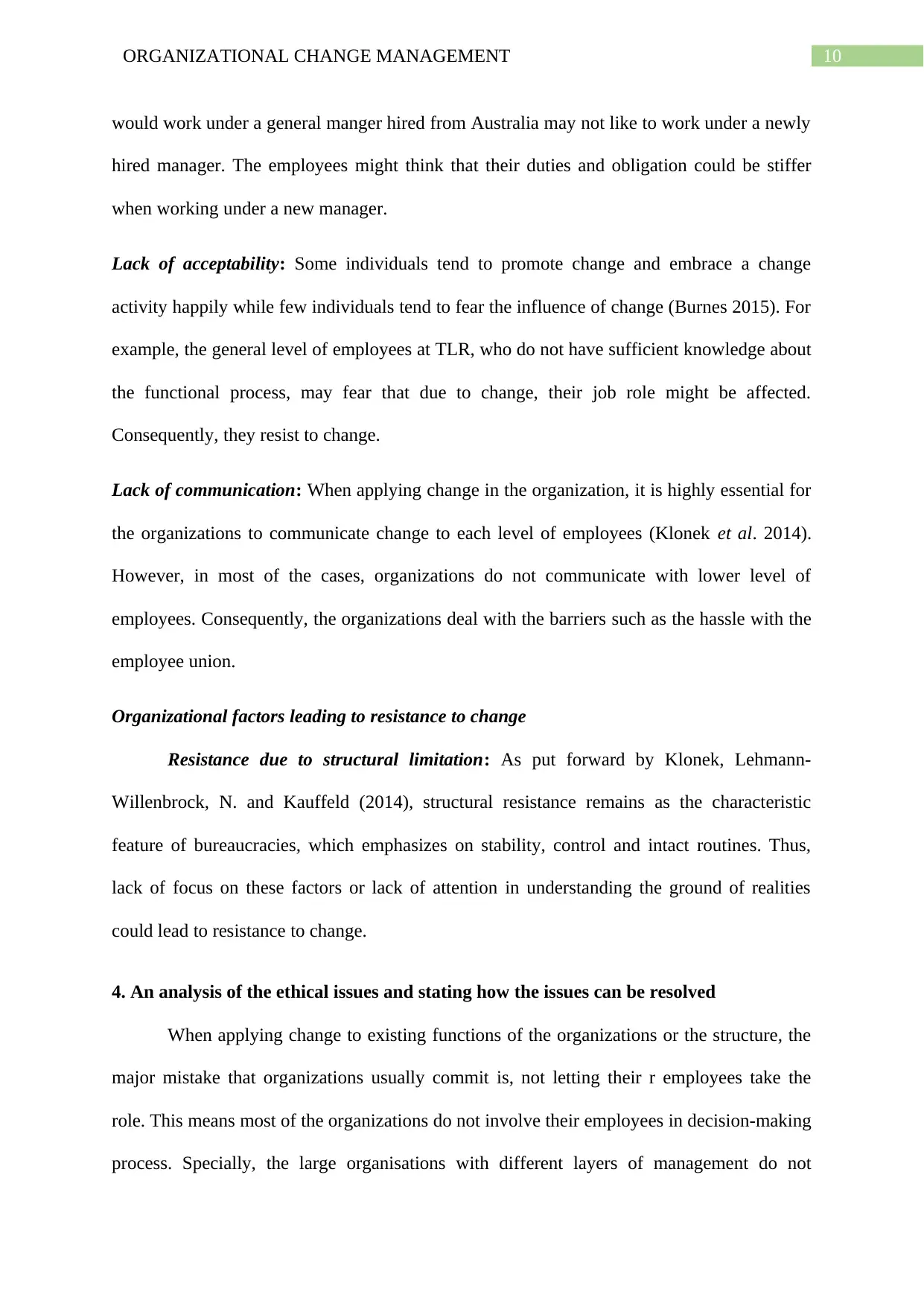
10ORGANIZATIONAL CHANGE MANAGEMENT
would work under a general manger hired from Australia may not like to work under a newly
hired manager. The employees might think that their duties and obligation could be stiffer
when working under a new manager.
Lack of acceptability: Some individuals tend to promote change and embrace a change
activity happily while few individuals tend to fear the influence of change (Burnes 2015). For
example, the general level of employees at TLR, who do not have sufficient knowledge about
the functional process, may fear that due to change, their job role might be affected.
Consequently, they resist to change.
Lack of communication: When applying change in the organization, it is highly essential for
the organizations to communicate change to each level of employees (Klonek et al. 2014).
However, in most of the cases, organizations do not communicate with lower level of
employees. Consequently, the organizations deal with the barriers such as the hassle with the
employee union.
Organizational factors leading to resistance to change
Resistance due to structural limitation: As put forward by Klonek, Lehmann-
Willenbrock, N. and Kauffeld (2014), structural resistance remains as the characteristic
feature of bureaucracies, which emphasizes on stability, control and intact routines. Thus,
lack of focus on these factors or lack of attention in understanding the ground of realities
could lead to resistance to change.
4. An analysis of the ethical issues and stating how the issues can be resolved
When applying change to existing functions of the organizations or the structure, the
major mistake that organizations usually commit is, not letting their r employees take the
role. This means most of the organizations do not involve their employees in decision-making
process. Specially, the large organisations with different layers of management do not
would work under a general manger hired from Australia may not like to work under a newly
hired manager. The employees might think that their duties and obligation could be stiffer
when working under a new manager.
Lack of acceptability: Some individuals tend to promote change and embrace a change
activity happily while few individuals tend to fear the influence of change (Burnes 2015). For
example, the general level of employees at TLR, who do not have sufficient knowledge about
the functional process, may fear that due to change, their job role might be affected.
Consequently, they resist to change.
Lack of communication: When applying change in the organization, it is highly essential for
the organizations to communicate change to each level of employees (Klonek et al. 2014).
However, in most of the cases, organizations do not communicate with lower level of
employees. Consequently, the organizations deal with the barriers such as the hassle with the
employee union.
Organizational factors leading to resistance to change
Resistance due to structural limitation: As put forward by Klonek, Lehmann-
Willenbrock, N. and Kauffeld (2014), structural resistance remains as the characteristic
feature of bureaucracies, which emphasizes on stability, control and intact routines. Thus,
lack of focus on these factors or lack of attention in understanding the ground of realities
could lead to resistance to change.
4. An analysis of the ethical issues and stating how the issues can be resolved
When applying change to existing functions of the organizations or the structure, the
major mistake that organizations usually commit is, not letting their r employees take the
role. This means most of the organizations do not involve their employees in decision-making
process. Specially, the large organisations with different layers of management do not
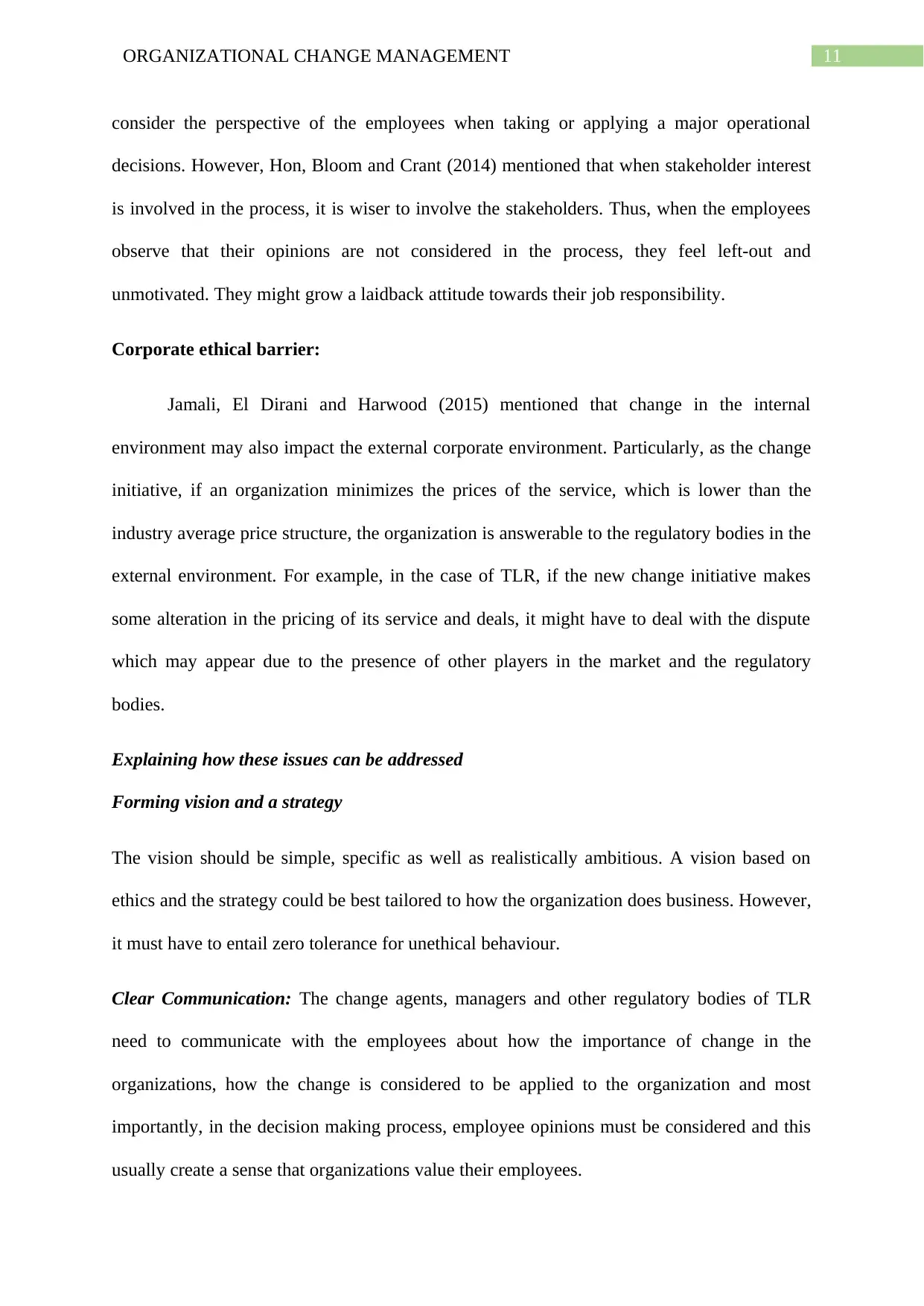
11ORGANIZATIONAL CHANGE MANAGEMENT
consider the perspective of the employees when taking or applying a major operational
decisions. However, Hon, Bloom and Crant (2014) mentioned that when stakeholder interest
is involved in the process, it is wiser to involve the stakeholders. Thus, when the employees
observe that their opinions are not considered in the process, they feel left-out and
unmotivated. They might grow a laidback attitude towards their job responsibility.
Corporate ethical barrier:
Jamali, El Dirani and Harwood (2015) mentioned that change in the internal
environment may also impact the external corporate environment. Particularly, as the change
initiative, if an organization minimizes the prices of the service, which is lower than the
industry average price structure, the organization is answerable to the regulatory bodies in the
external environment. For example, in the case of TLR, if the new change initiative makes
some alteration in the pricing of its service and deals, it might have to deal with the dispute
which may appear due to the presence of other players in the market and the regulatory
bodies.
Explaining how these issues can be addressed
Forming vision and a strategy
The vision should be simple, specific as well as realistically ambitious. A vision based on
ethics and the strategy could be best tailored to how the organization does business. However,
it must have to entail zero tolerance for unethical behaviour.
Clear Communication: The change agents, managers and other regulatory bodies of TLR
need to communicate with the employees about how the importance of change in the
organizations, how the change is considered to be applied to the organization and most
importantly, in the decision making process, employee opinions must be considered and this
usually create a sense that organizations value their employees.
consider the perspective of the employees when taking or applying a major operational
decisions. However, Hon, Bloom and Crant (2014) mentioned that when stakeholder interest
is involved in the process, it is wiser to involve the stakeholders. Thus, when the employees
observe that their opinions are not considered in the process, they feel left-out and
unmotivated. They might grow a laidback attitude towards their job responsibility.
Corporate ethical barrier:
Jamali, El Dirani and Harwood (2015) mentioned that change in the internal
environment may also impact the external corporate environment. Particularly, as the change
initiative, if an organization minimizes the prices of the service, which is lower than the
industry average price structure, the organization is answerable to the regulatory bodies in the
external environment. For example, in the case of TLR, if the new change initiative makes
some alteration in the pricing of its service and deals, it might have to deal with the dispute
which may appear due to the presence of other players in the market and the regulatory
bodies.
Explaining how these issues can be addressed
Forming vision and a strategy
The vision should be simple, specific as well as realistically ambitious. A vision based on
ethics and the strategy could be best tailored to how the organization does business. However,
it must have to entail zero tolerance for unethical behaviour.
Clear Communication: The change agents, managers and other regulatory bodies of TLR
need to communicate with the employees about how the importance of change in the
organizations, how the change is considered to be applied to the organization and most
importantly, in the decision making process, employee opinions must be considered and this
usually create a sense that organizations value their employees.
⊘ This is a preview!⊘
Do you want full access?
Subscribe today to unlock all pages.

Trusted by 1+ million students worldwide
1 out of 16
Related Documents
Your All-in-One AI-Powered Toolkit for Academic Success.
+13062052269
info@desklib.com
Available 24*7 on WhatsApp / Email
![[object Object]](/_next/static/media/star-bottom.7253800d.svg)
Unlock your academic potential
Copyright © 2020–2025 A2Z Services. All Rights Reserved. Developed and managed by ZUCOL.





